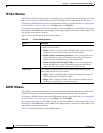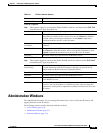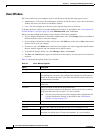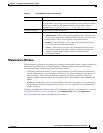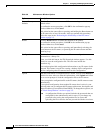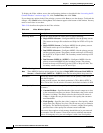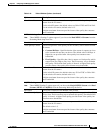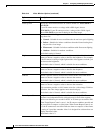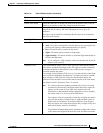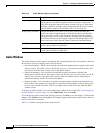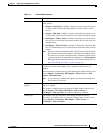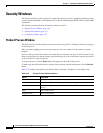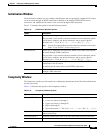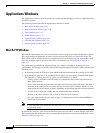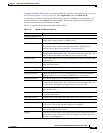
3-22
Cisco Video Surveillance 2500 Series IP Camera User Guide
OL-19273-02
Chapter 3 Configuring and Managing the IP Camera
Audio/Video Windows
Video Adjustment
Video System Choose the media format that the IP camera should use: NTSC/60 Hz or
PAL/50 Hz.
If your IP camera receives a voltage with a 60Hz signal, choose
NTSC/60
Hz. If your IP camera receives a voltage with a 50 Hz signal,
choose PAL/50
Hz to prevent flickering in the video image.
Preset Choose one the following preset white balance modes from the Preset
drop-down list:
• Normal—Suitable for most conditions that do not have special lighting
• Indoor—Suitable for indoor conditions when the Normal setting does
not provide a clear image
• Fluorescent—Suitable for indoor conditions with fluorescent lighting
• Outdoor—Suitable for outdoor conditions
The default setting is Normal.
Brightness Choose a positive value to increase the brightness of the video from the IP
camera or choose a negative value to decrease the brightness. For example,
if the IP camera is facing a bright light and the video appears too dark, you
can increase the brightness.
The default value is Normal, which is suitable for most conditions.
Sharpness Choose a positive value to increase the sharpness of the video from the IP
camera or choose a negative value to decrease the sharpness.
The default value is Normal, which is suitable for most conditions.
Contrast Choose a positive value to increase the contrast of the video from the IP
camera or choose a negative value to decrease the contrast.
The default value is Normal, which is suitable for most conditions.
Saturation Choose a positive value to increase the saturation of the video from the IP
camera or choose a negative value to decrease the saturation.
High saturation provides a vivid, intense color for a video image. With less
saturation, the video image appears more muted and gray.
The default value is Normal, which is suitable for most conditions.
Frame Repeat Count Designates how video output from the IP camera displays. The IP camera
generates two independent fields (odd and even) for each video capture,
which occur 60 times per second for NTSC or 50 times per second for PAL.
When Frame Repeat Count is set to 1, the IP camera combines one odd and
one even field to compose a video frame. When Frame Repeat Count is set
to 2, the IP camera uses one of the fields two times to compose a video frame.
A setting of 1 provides smoother video. It is designed for software that can
display interlaced video.
The default value is 2.
Table 3-10 Video Window Options (continued)
Option Description



